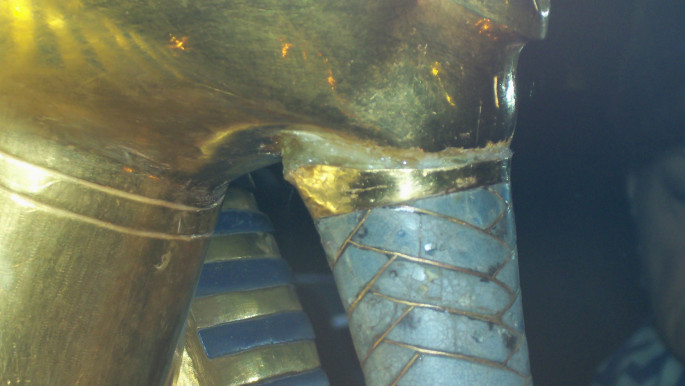Experts aim for end-of-year repair of King Tut's beard
Experts aim for end-of-year repair of King Tut's beard
A German antiquity restoration expert has said Tutankhamun's golden mask will be repaired by the end of the year, after its false beard was damaged and hastily botched back on.
2 min read
The beard fell from the mask in an August 2014 accident [Getty]
Restoration experts aim to have removed a crust of dried glue from the beard of pharaoh Tutankhamun's priceless golden mask by the end of the year, a German specialist said this week.
The beard fell from the mask in an August 2014 accident at the Egyptian Antiquities Museum in Cairo, leading to its botched repair by employees.
The intricate operation "might be finished by end of this year or say in two months", Christian Eckmann, a specialist in restoration work on antiquities in glass and metal told reporters at a press conference held at the museum.
"We have not yet taken off the beard," he said.
The funerary mask is being restored in a room at the museum, and the golden relic with the beard still attached to it was shown to journalists as Eckmann's team worked.
The beard had fallen off when the mask was removed to repair the lighting of its display case.
In a hurried attempt to fix the beard, employees used too much epoxy glue to fix the relic, leaving crust of the chemical behind.
Eckmann, who said on October 10 when the repairs started that the damage was reversible, said Tuesday that the restoration work would be carried out in two stages.
The beard would be detached and re-attached, followed by "a comprehensive study of the material used to manufacture" the mask.
The restoration work is being done manually, with the use of thin "wooden sticks" to remove the crust of dried glue, he said.
Al-Araby al-Jadeed's Arabic service broke the story of the damaged mask in January, after conservationists spoke out - on condition of anonymity, for fear of professional reprisals.
Howard Carter and George Herbert discovered Tutankhamun's burial mask in the pharaoh's nearly intact tomb in 1922 in Luxor's Valley of the Kings, where the powerful nobles of the New Kingdom were buried, around 1300BC.
King Tut was the son of the Akhenaten, who tried to change Ancient Egyptian religion by exclusively worshipping Aten, the sun disc.
Tut ruled for about ten years and died at the age of 19. His relative unimportance and the nearby construction of other kings' tombs covered the entrance of his small and hastily built tomb with rubble, meaning it was left untouched by grave-robbers before Carter's discovery.
In August, a British Egyptologist said he believes the final resting place of Queen Nefertiti could lie just yards beyond the tomb of the boy king.
The beard fell from the mask in an August 2014 accident at the Egyptian Antiquities Museum in Cairo, leading to its botched repair by employees.
The intricate operation "might be finished by end of this year or say in two months", Christian Eckmann, a specialist in restoration work on antiquities in glass and metal told reporters at a press conference held at the museum.
"We have not yet taken off the beard," he said.
 |
|
| AAAJ's Arabic service broke the story of the beard in Jan [AAAJ] |
The beard had fallen off when the mask was removed to repair the lighting of its display case.
In a hurried attempt to fix the beard, employees used too much epoxy glue to fix the relic, leaving crust of the chemical behind.
Eckmann, who said on October 10 when the repairs started that the damage was reversible, said Tuesday that the restoration work would be carried out in two stages.
The beard would be detached and re-attached, followed by "a comprehensive study of the material used to manufacture" the mask.
The restoration work is being done manually, with the use of thin "wooden sticks" to remove the crust of dried glue, he said.
Al-Araby al-Jadeed's Arabic service broke the story of the damaged mask in January, after conservationists spoke out - on condition of anonymity, for fear of professional reprisals.
Howard Carter and George Herbert discovered Tutankhamun's burial mask in the pharaoh's nearly intact tomb in 1922 in Luxor's Valley of the Kings, where the powerful nobles of the New Kingdom were buried, around 1300BC.
King Tut was the son of the Akhenaten, who tried to change Ancient Egyptian religion by exclusively worshipping Aten, the sun disc.
Tut ruled for about ten years and died at the age of 19. His relative unimportance and the nearby construction of other kings' tombs covered the entrance of his small and hastily built tomb with rubble, meaning it was left untouched by grave-robbers before Carter's discovery.
In August, a British Egyptologist said he believes the final resting place of Queen Nefertiti could lie just yards beyond the tomb of the boy king.
![Twenty-four hours in the Middle East [Getty] Twenty-four hours in the Middle East [Getty]](/sites/default/files/styles/large_16_9/public/media/images/A489F3CA-EA67-4648-8C6F-86915F679417.jpg?h=d1cb525d&itok=rOCf2efh)

![Hundreds demonstrate against the White House Correspondents' Dinner in support of Gazan journalists. [Brooke Anderson/TNA]](/sites/default/files/styles/image_330x185/public/2024-04/5cde0bce-4652-4e28-a001-f06b9b8f8e28.jpg?h=ddb1ad0c&itok=R_uaRAn7)
